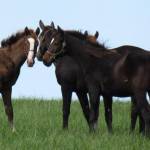Identifying Lost or Stolen Horses

A big tree limb falls, knocking down part of your fence, and your horses decide to go exploring. After a tornado devastates your area, ponies are seen wandering in a public park. Horses tied to a trailer at a show are there one minute and have disappeared the next. Before this scenario takes place, what can you do to make it easier to identify your horses and get them back home?
First, get pictures of each horse. Take clear, well-lit, high-resolution pictures from the horse’s front, rear, and each side. If your horse has markings on his face or legs, get separate pictures of those features. Print the pictures and put them in an album with a separate record page for each horse. Add details such as the horse’s breed, size, weight, birth year, registration number, and a description of distinguishing marks. Next, make a second copy of the photos and information and send this to a friend or family member who lives some distance away. If your only photos and descriptions are accidentally erased from your computer, blown away in a storm, or ruined in a flood, this extra set will be invaluable in identifying and reclaiming any horses that might be missing.
Methods of permanent identification include brands, lip tattoos, and microchips. These markings or implants stay with the horse forever and are the best idea to guarantee your horse can be positively identified. Microchipped horses can be reunited with their owners even if they are found several states away, while brands might be familiar only to people in a relatively small local area.
If a storm or flood is predicted, temporary identification can be done in a variety of ways. Some suggestions are clipping your phone number into the horse’s coat; braiding a luggage tag into his mane; using spray paint or permanent marker to write on his coat; branding or writing a phone number onto a hoof; and having him wear a halter or neck strap with your name and phone number. Don’t count only on information on a halter nameplate; halters can be lost, broken, snagged on debris, or taken off by whoever handles the horse.
While natural disasters can’t be prevented, there are some steps you can take to make it harder for a thief to steal horses from your barn or pasture. Keeping gates locked provides some security, though it’s inconvenient to stop, unlock gates, pass through, and lock them behind you. If you do secure your entrances, use strong chains and locks, and chain both sides of the gate to heavy posts so the gate can’t be easily lifted off its hinges. Locking barns and stall doors is generally not advised, as it hinders quick evacuation of horses in case of a fire or other emergency.
At shows or trail rides, minimize times when the horses are left tied to a trailer with no one around. It’s easy for a thief to walk up, untie a horse, load it into a trailer, and leave the show grounds without anyone noticing.
If you have reason to think your horse has been stolen, notify police immediately. Posting a description on one or more websites that have been set up to locate stolen horses is also a good idea.








